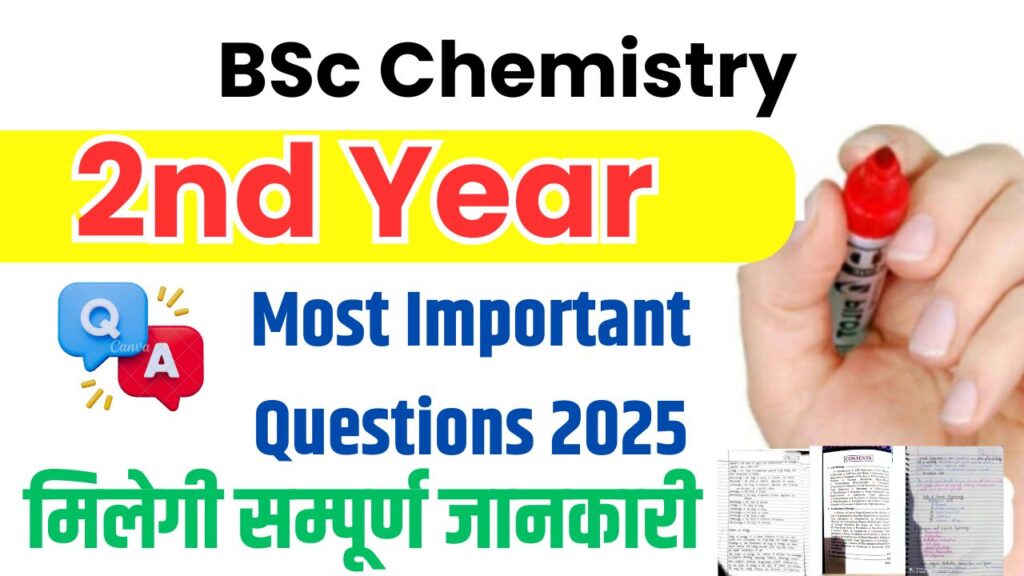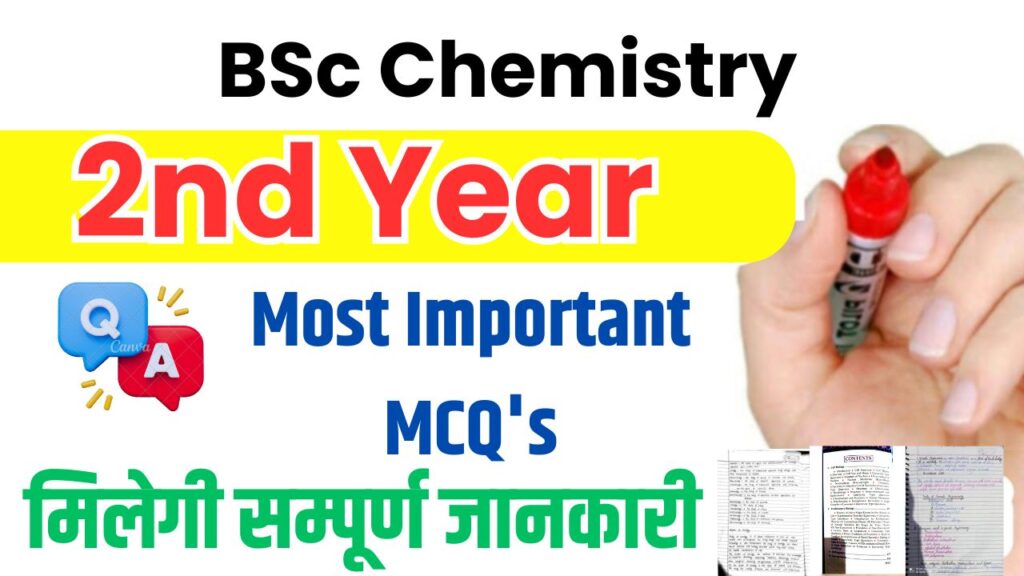नमस्कार साथियों क्या आप जानना चाहते है BSc 2nd Year Chemistry Most Important Questions 2025 के बारे में? दोस्तों आपका स्वागत है इस लेख में, हम आपको BSC 1st Year Organic Chemistry Important Questions in Hindi के साथ BSc 2nd Year Chemistry Most Important Questions 2025 in Hindi के बारे में सब कुछ बताएंगे।

जैसा कि आप जानते हैं Chemistry एक बहुत ही दिमाग लगाने वाला subject है, तो इस लेख में हमने BSc 2nd Year Chemistry Most Important Questions 2025 इकट्ठा किया है जो कि आपको पढ़ने में मदत करेंगे अगर आप इस लेख में बताए हुए Important Questions को एक बार रट लेंगे तो आप समझ लो 60% syllabus cover हो जाएगा, तो BSc 2nd Year Chemistry Most Important Questions 2025 की पूरी सूची पढ़ने के लिए इस लेख को अंत तक जरूर पढ़ें ।
यह BSc 2nd Year Chemistry के महत्वपूर्ण प्रश्न 2024 प्रतिष्ठित संस्थानों के अनुभवी शिक्षकों द्वारा तैयार किए गए हैं, इन प्रश्नों के पेपर में आने की अधिक संभावना है, इसलिए इन्हें अच्छी तरह से तैयार करें।
BSc 2nd Year Chemistry Most Important Questions 2025

Explain the structure and bonding in benzene according to the molecular orbital theory.
(आण्विक कक्षीय सिद्धांत के अनुसार बेंजीन की संरचना और बंधन को समझाइए।)
What is the mechanism of aldol condensation? Provide an example.
(एल्डोल संघनन की प्रक्रिया क्या है? एक उदाहरण दें।)
Describe the laws of thermodynamics and their significance in chemical reactions.
(ऊष्मागतिकी के नियमों का वर्णन कीजिए और रासायनिक अभिक्रियाओं में उनकी प्रासंगिकता को समझाइए।)
What is a coordination compound? Explain Werner’s coordination theory.
(समन्वय यौगिक क्या है? वर्नर की समन्वय सिद्धांत को समझाइए।)
Discuss the SN1 and SN2 mechanisms of nucleophilic substitution reactions with examples.
(उदाहरण सहित न्यूक्लियोफिलिक प्रतिस्थापन अभिक्रियाओं के SN1 और SN2 प्रक्रिया पर चर्चा कीजिए।)
Explain the concept of entropy and its role in spontaneous reactions.
(एंट्रॉपी की अवधारणा और स्वतःस्फूर्त अभिक्रियाओं में इसकी भूमिका को समझाइए।)
What are colloids? Describe their properties and types with examples.
(कोलॉइड्स क्या हैं? उनके गुण और प्रकार को उदाहरण सहित वर्णित कीजिए।)
Define and explain the term ‘Electrochemical Series’. What is its importance?
(विद्युत रासायनिक श्रेणी को परिभाषित और समझाइए। इसका क्या महत्व है?)
Explain the concept of quantum numbers and their significance in determining the electron configuration of atoms.
(क्वांटम संख्याओं की अवधारणा को समझाइए और परमाणुओं के इलेक्ट्रॉन विन्यास में उनकी प्रासंगिकता को वर्णित कीजिए।)
What is the difference between a primary, secondary, and tertiary alcohol? Give examples.
(प्राथमिक, द्वितीयक, और तृतीयक अल्कोहल में क्या अंतर है? उदाहरण दीजिए।)
Discuss the principle of UV-Visible Spectroscopy and its application in chemical analysis.
(यूवी-विशिबल स्पेक्ट्रोस्कोपी के सिद्धांत और रासायनिक विश्लेषण में इसके अनुप्रयोगों पर चर्चा कीजिए।)
What is catalysis? Explain homogeneous and heterogeneous catalysis with examples.
(उत्प्रेरण क्या है? उदाहरण सहित समांग और विषमांग उत्प्रेरण को समझाइए।)
Describe the different types of crystal structures found in solids with examples.
(ठोसों में पाई जाने वाली विभिन्न प्रकार की क्रिस्टल संरचनाओं का उदाहरण सहित वर्णन कीजिए।)
Explain the mechanism of electrophilic aromatic substitution reactions with an example.
(उदाहरण सहित इलेक्ट्रोफिलिक एरोमैटिक प्रतिस्थापन अभिक्रियाओं की प्रक्रिया को समझाइए।)
What are the different methods of extraction of metals? Describe the electrolytic reduction process.
(धातुओं के निष्कर्षण के विभिन्न तरीकों का वर्णन कीजिए। विद्युत अपचयन प्रक्रिया को समझाइए।)
BSc 2nd Year Chemistry Most Important MCQ’s

Which of the following is the most stable allotrope of carbon?
- A) Graphite
- B) Diamond
- C) Fullerene
- D) Carbon nanotubes
Answer: A) Graphite
Explanation: Graphite is the most stable allotrope of carbon under standard conditions because of its layered structure and strong covalent bonds between carbon atoms within each layer.
In a coordination compound, the central metal ion is surrounded by:
- A) Ligands
- B) Isotopes
- C) Ions
- D) None of these
Answer: A) Ligands
Explanation: Ligands are molecules or ions that donate electron pairs to the central metal ion in a coordination compound, forming a complex.
Which of the following has the highest boiling point?
- A) Methanol
- B) Ethanol
- C) Propanol
- D) Butanol
Answer: D) Butanol
Explanation: Boiling point increases with molecular weight; butanol, with the longest carbon chain among these alcohols, has the highest boiling point due to increased van der Waals forces.
Which quantum number defines the shape of an orbital?
- A) Principal quantum number (n)
- B) Azimuthal quantum number (l)
- C) Magnetic quantum number (m)
- D) Spin quantum number (s)
Answer: B) Azimuthal quantum number (l)
Explanation: The azimuthal quantum number (l) determines the shape of an orbital, with different values corresponding to s, p, d, and f orbitals.
What is the general formula of alkenes?
- A) CnH2n+2
- B) CnH2n
- C) CnH2n-2
- D) CnH2n-6
Answer: B) CnH2n
Explanation: Alkenes are hydrocarbons with a double bond and have the general formula CnH2n.
Which theory explains the color of transition metal complexes?
- A) Molecular Orbital Theory
- B) Crystal Field Theory
- C) VSEPR Theory
- D) Dalton’s Atomic Theory
Answer: B) Crystal Field Theory
Explanation: Crystal Field Theory explains the color of transition metal complexes by showing how the d-orbitals split in the presence of ligands, allowing for electronic transitions that absorb visible light.
Which type of reaction is represented by: 2H₂O → 2H₂ + O₂?
- A) Decomposition reaction
- B) Combination reaction
- C) Single displacement reaction
- D) Double displacement reaction
Answer: A) Decomposition reaction
Explanation: This is a decomposition reaction where a single compound (water) breaks down into simpler substances (hydrogen and oxygen gases).
Which of the following compounds does NOT exhibit hydrogen bonding?
- A) Water (H₂O)
- B) Ammonia (NH₃)
- C) Methane (CH₄)
- D) Ethanol (C₂H₅OH)
Answer: C) Methane (CH₄)
Explanation: Methane does not exhibit hydrogen bonding because it lacks highly electronegative atoms (like N, O, F) attached to hydrogen.
Which law is used to determine the rate constant for a reaction?
- A) Boyle’s Law
- B) Rate Law
- C) Charles’s Law
- D) Dalton’s Law
Answer: B) Rate Law
Explanation: The rate law expresses the rate of a reaction as a function of the concentration of reactants and the rate constant.
Which metal is extracted from its ore using the Bayer process?
- A) Iron
- B) Copper
- C) Aluminum
- D) Silver
Answer: C) Aluminum
Explanation: The Bayer process is used to purify bauxite, the primary ore of aluminum, converting it to aluminum oxide before electrolytic reduction.
Which is the reducing agent in the reaction: Fe₂O₃ + 3CO → 2Fe + 3CO₂?
- A) Fe₂O₃
- B) CO
- C) Fe
- D) CO₂
Answer: B) CO
Explanation: Carbon monoxide (CO) is the reducing agent as it donates electrons, reducing Fe₂O₃ to Fe.
The main product in the nitration of benzene is:
- A) Benzene sulfonic acid
- B) Nitrobenzene
- C) Toluene
- D) Benzaldehyde
Answer: B) Nitrobenzene
Explanation: In the nitration of benzene, a nitro group (-NO₂) is substituted onto the benzene ring to form nitrobenzene.
Which acid is known as the ‘king of chemicals’?
- A) Hydrochloric acid
- B) Sulfuric acid
- C) Nitric acid
- D) Acetic acid
Answer: B) Sulfuric acid
Explanation: Sulfuric acid is often referred to as the ‘king of chemicals’ due to its wide range of applications in various industries.
In electrochemistry, the standard hydrogen electrode is assigned a potential of:
- A) 1 V
- B) 0 V
- C) -1 V
- D) 0.5 V
Answer: B) 0 V
Explanation: The standard hydrogen electrode (SHE) is the reference electrode in electrochemistry, assigned a potential of 0 V under standard conditions.
The molecular geometry of ammonia (NH₃) is:
- A) Linear
- B) Tetrahedral
- C) Trigonal planar
- D) Trigonal pyramidal
Answer: D) Trigonal pyramidal
Explanation: Ammonia (NH₃) has a trigonal pyramidal geometry due to the lone pair on nitrogen, which repels the bonding pairs of electrons.
Also Read: Bsc 1st year Physical Chemistry Important Questions 2025 पक्का आयेंगे ये प्रश्न
हमें उम्मीद है कि इस लेख की मदद से आपको BSc 2nd Year Chemistry Most Important Questions 2025 के बारे में जानकारी मिल गई होगी।
दोस्तों आपको यह पोस्ट कैसी लगी कृपया हमें कमेंट सेक्शन में बताएं और यदि आपके कोई प्रश्न हों तो बेझिझक हमसे Comment Box में पूछ सकते हैं। यदि आपको यह पोस्ट उपयोगी लगी तो कृपया इसे दूसरों के साथ साझा करें।